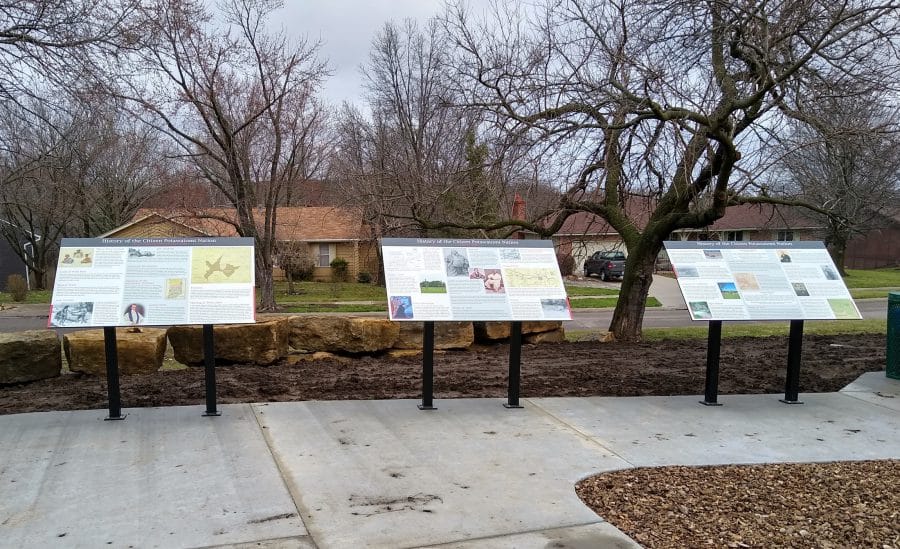The Citizen Potawatomi Nation and Shawnee County Parks and Recreation Department partnered to highlight the history of Burnett’s Mound at Skyline Park in Topeka, Kansas. Named after 19th century Potawatomi Chief Abram Burnett, the mound is Topeka’s highest elevated point. The display at its base opened spring 2020 and features three informational panels.
“The new exhibit lets people know that we were here and that we’re still here,” said Citizen Potawatomi Nation District 4 Legislator Jon Boursaw.

On top of serving as the District 4 Legislator, Boursaw studies Potawatomi and Kansas history. He takes every opportunity to educate others through presentations, writing and leading events. Because of this, he set out to build a partnership between CPN and the Shawnee County Parks and Recreation Department to showcase the role Potawatomi played in Topeka’s development as well as Burnett’s Mound’s namesake.
“I hope it helps people have a greater appreciation for us, and at least, an acknowledgement of why it’s called Burnett’s Mound,” he added.
“I think it’s important that people know who Burnett was and that the Potawatomi did have a major presence in what is now Shawnee County prior to it becoming a county.”
Chief Burnett
Abram Burnett, Nanweshmah (He who prays with plants), was born in Indiana near the Tippecanoe River in November 1812. After Burnett’s real father, Chief Shauquebe, passed away, his mother’s cousin, also named Abraham Burnett, adopted him, resulting in his English name: Abraham or Abram B. Burnett.
Chief Burnett studied at a Baptist mission in Fort Wayne, Indiana, under Reverend Isaac McCoy and at the Choctaw Academy in Kentucky. In 1838, he and his family were forcibly removed from Indiana to present-day Kansas on the Trail of Death. During the removal, Chief Burnett utilized his skills to serve fellow Potawatomi on the long, hard 660-mile journey.
“Abram Burnett learned how to read, write and speak English while attending Choctaw Indian Academy in Kentucky, and because of his background, he served as an interpreter on the Trail of Death,” Boursaw said. “But when he arrived, there was nothing here.”
Although the Potawatomi are Eastern woodland people, many Tribal members succeeded on the Kansas prairies, including Chief Burnett. He settled the mound in 1848 and began taking advantage of the economic opportunities the Oregon Trail provided as travelers crossed the Potawatomi Reservation.
“Abram Burnett was a man of commerce, and he had a role in helping Shawnee County become what it is today,” Boursaw said. “He was successful with the travelers that were on the Oregon Trail. He was a prosperous livestock trader, and he was also a farmer.”
He passed away in 1870 and was known as the largest man in Kansas at 450 pounds. While local rumors indicate the mound serves as Chief Burnett’s final resting place, his grave is on land west of Skyline Park. Also, many in northeastern Kansas believe that Chief Burnett said no one should ever disturb the mound due to its sacredness or else face harsh repercussions because the Great Spirit looks out for its well-being.
According to the story, the mound protected the area from tornadoes. However, in the 1960s, interstate construction began, cutting into the hill’s base and leveling a portion at the top to place a water tank. In 1966, a violent F5 tornado caused more than $200 million in damages and killed 17 people.
Whether the legend holds any truth may never be determined. However, it remains clear that Chief Burnett’s legacy serves as a reminder of the hardships the Potawatomi and other Native communities overcame post-removal to build their homes and businesses in unfamiliar lands.
For more information on the Citizen Potawatomi Nation, visit potawatomi.org.
